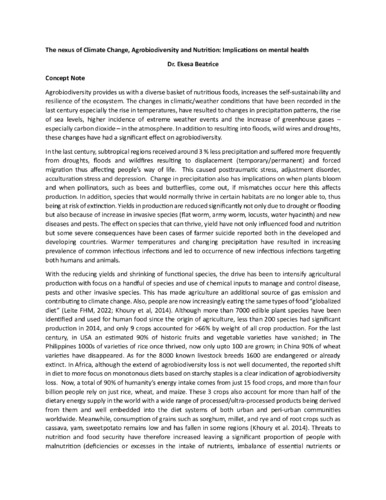Keynote Speech. The nexus of climate change, agrobiodiversity and nutrition: Implications on mental health
Agrobiodiversity provides us with a diverse basket of nutritious foods, increases the self-sustainability and resilience of the ecosystem. The changes in climatic/weather conditions that have been recorded in the last century especially the rise in temperatures, have resulted to changes in precipitation patterns, the rise of sea levels, higher incidence of extreme weather events and the increase of greenhouse gases – especially carbon dioxide – in the atmosphere. In addition to resulting into floods, wild wires and droughts, these changes have had a significant effect on agrobiodiversity.
In the last century, subtropical regions received around 3 % less precipitation and suffered more frequently from droughts, floods and wildfires resulting to displacement (temporary/permanent) and forced migration thus affecting people’s way of life. This caused posttraumatic stress, adjustment disorder, acculturation stress and depression. Change in precipitation also has implications on when plants bloom and when pollinators, such as bees and butterflies, come out, if mismatches occur here this affects production. In addition, species that would normally thrive in certain habitats are no longer able to, thus being at risk of extinction. Yields in production are reduced significantly not only due to drought or flooding but also because of increase in invasive species (flat worm, army worm, locusts, water hyacinth) and new diseases and pests. The effect on species that can thrive, yield have not only influenced food and nutrition but some severe consequences have been cases of farmer suicide reported both in the developed and developing countries. Warmer temperatures and changing precipitation have resulted in increasing prevalence of common infectious infections and led to occurrence of new infectious infections targeting both humans and animals.
With the reducing yields and shrinking of functional species, the drive has been to intensify agricultural production with focus on a handful of species and use of chemical inputs to manage and control disease, pests and other invasive species. This has made agriculture an additional source of gas emission and contributing to climate change. Also, people are now increasingly eating the same types of food “globalized diet” (Leite FHM, 2022; Khoury et al, 2014). Although more than 7000 edible plant species have been identified and used for human food since the origin of agriculture, less than 200 species had significant production in 2014, and only 9 crops accounted for >66% by weight of all crop production. For the last century, in USA an estimated 90% of historic fruits and vegetable varieties have vanished; in The Philippines 1000s of varieties of rice once thrived, now only upto 100 are grown; in China 90% of wheat varieties have disappeared. As for the 8000 known livestock breeds 1600 are endangered or already extinct. In Africa, although the extend of agrobiodiversity loss is not well documented, the reported shift in diet to more focus on monotonous diets based on starchy staples is a clear indication of agrobiodiversity loss. Now, a total of 90% of humanity’s energy intake comes from just 15 food crops, and more than four billion people rely on just rice, wheat, and maize. These 3 crops also account for more than half of the dietary energy supply in the world with a wide range of processed/ultra-processed products being derived from them and well embedded into the diet systems of both urban and peri-urban communities worldwide. Meanwhile, consumption of grains such as sorghum, millet, and rye and of root crops such as cassava, yam, sweetpotato remains low and has fallen in some regions (Khoury et al. 2014). Threats to nutrition and food security have therefore increased leaving a significant proportion of people with malnutrition (deficiencies or excesses in the intake of nutrients, imbalance of essential nutrients or impaired use of nutrients) and increasing prevalences of non-communicable diseases (NCDs). The linkages between poor diets at all life-cycle stages have greatly been linked to mental health and Mental health also influences our dietary practices.

